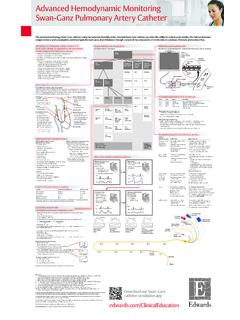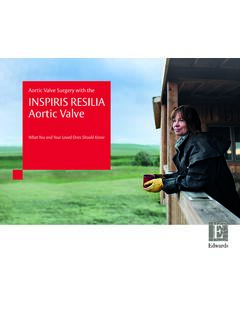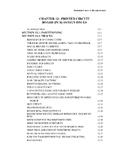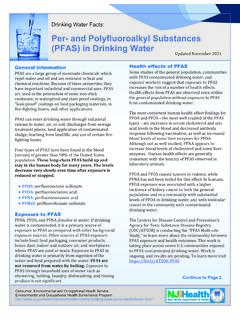Transcription of Dear Imaging Center - .NET Framework
1 PP--US-0878 Page 1 of 25 Dear Imaging Center : This letter is in response to your inquiry concerning the safety of performing magnetic resonance (MR) procedures in patients who have been implanted with Edwards Lifesciences LLC (formerly Baxter Healthcare Corporation, CardioVascular Group) heart valve therapy products. MR Information: MR procedures have been performed on numerous occasions on patients with Edwards implantable products without reported problems. The products listed below are made from non-ferromagnetic, weakly ferromagnetic materials or paramagnetic materials. For all products, the in vivo forces are greater than those pertaining to the magnetic field interactions ( , the forces associated with translational attraction and torque are less than those associated with gravitational forces).
2 Thus, these products are considered safe for patients undergoing magnetic resonance Imaging (MRI) procedures using MR systems operating under the conditions described in the following pages. Product Information: Replacement Heart Valve Product Description (Stented Tissue) Models Reference Carpentier-Edwards aortic and mitral bioprostheses 2625, 6625 12, 20, 21 Carpentier-Edwards aortic bioprosthesis 2650 12, 20, 21 Carpentier-Edwards Duraflex low pressure porcine mitral bioprosthesis 6625LP 12, 20, 21 Carpentier-Edwards Duraflex low pressure porcine mitral bioprosthesis with extended sewing ring 6625-ESR-LP 12, 20, 21 Carpentier-Edwards bioprosthetic valved conduit 4300 12, 20, 21 Non-clinical testing has demonstrated that these devices are MR Conditional.
3 A patient with these devices can be scanned safely immediately after placement of the implant under the following conditions: Static magnetic field of 3 tesla or less. Spatial gradient field of 3000 gauss/cm or less. Maximum MR system-reported whole-body-averaged specific absorption rate (SAR) of W/kg for 15 minutes of continuous scanning per sequence in the normal operating mode. Under the scan conditions defined above these devices are expected to produce a maximum temperature rise of 3 C after 15 minutes of continuous scanning. In non-clinical testing, the image artifact caused by these devices extends approximately as far as 30 mm from the devices when imaged with a gradient echo pulse sequence and approximately as far as 14 mm from the devices when imaged with a spin echo pulse sequence in a 3 T MRI system.
4 The lumen is partially to fully obscured under these conditions. MR image quality may be compromised if the area of interest is in the same area or relatively close to the position of these devices . Optimization of MR Imaging parameters is recommended. The valve wireform stent is composed of a corrosion-resistant cobalt-chromium spring alloy that is commonly used in implantable devices . The nominal composition (wt. percent) is as follows: Cobalt Chromium Nickel Molybdenum Manganese Carbon Beryllium Iron 40% 20% 15% 7% 2% < < Bal PP--US-0878 Page 2 of 25 Replacement Heart Valve Product Description (Stented Tissue) Models Reference Carpentier-Edwards PERIMOUNT pericardial aortic bioprostheses 2700, 2700 TFX 18, 19, 20, 21, 22 Carpentier-Edwards PERIMOUNT RSR pericardial aortic bioprostheses 2800, 2800 TFX Carpentier-Edwards PERIMOUNT Magna pericardial aortic bioprostheses 3000, 3000 TFX Non-clinical testing has demonstrated that these devices are MR Conditional.
5 A patient with these valves can be scanned safely, immediately after placement of this valve under the following conditions: Static magnetic field of 3 tesla or less. Spatial gradient field of less than 3000 gauss/cm. Maximum MR system-reported whole-body-averaged specific absorption rate (SAR) of W/kg for 15 minutes of continuous scanning per sequence in the normal operating mode Under the scan conditions defined above these devices are expected to produce a maximum temperature rise of C after 15 minutes of continuous scanning. In non-clinical testing, the image artifact caused by these devices extends approximately as far as mm from the bioprostheses when imaged with a gradient echo pulse sequence and approximately as far as mm from the valves when imaged with a spin echo pulse sequence in a 3 T MRI system.
6 The lumen is partially to fully obscured under these conditions. MR image quality may be compromised if the area of interest is in the same area or relatively close to the position of the bioprostheses. Optimization of MR Imaging parameters is recommended. The valve wireform stent and orifice-stiffening band are composed of a corrosion-resistant cobalt -chromium spring alloy that is commonly used in implantable devices . The nominal composition (wt. percent) is as follows: Cobalt Chromium Nickel Molybdenum Manganese Carbon Beryllium Iron 40% 20% 15% 7% 2% < < Bal PP--US-0878 Page 3 of 25 Replacement Heart Valve Product Description (Stented Tissue) Model Reference Carpentier-Edwards PERIMOUNT Magna Ease pericardial aortic bioprosthesis 3300 TFX 19, 20, 21 Non-clinical testing has demonstrated that this device is MR Conditional.
7 A patient with this valve can be scanned safely, immediately after placement of this implant under the following conditions: Static magnetic field of 3 tesla or less. Spatial gradient field of less than 3000 gauss/cm. Maximum MR system-reported whole-body-averaged specific absorption rate (SAR) of W/kg for 15 minutes of continuous scanning per sequence in the normal operating mode Under the scan conditions defined above this device is expected to produce a maximum temperature rise of C after 15 minutes of continuous scanning. In non-clinical testing, the image artifact caused by the device extends approximately as far as mm from the bioprosthesis when imaged with a gradient echo pulse sequence and approximately as far as mm from the valve when imaged with a spin echo pulse sequence in a 3 T MRI system.
8 The lumen is partially to fully obscured under these conditions. MR image quality may be compromised if the area of interest is in the same area or relatively close to the position of the bioprosthesis. Optimization of MR Imaging parameters is recommended. The valve wireform stent and orifice-stiffening band are composed of a corrosion-resistant cobalt-chromium spring alloy that is commonly used in implantable devices . The nominal composition (wt. percent) is as follows: Cobalt Chromium Nickel Molybdenum Manganese Carbon Beryllium Iron 40% 20% 15% 7% 2% < < Bal PP--US-0878 Page 4 of 25 Replacement Heart Valve Product Description (Stented Tissue) Models Reference Carpentier-Edwards PERIMOUNT pericardial mitral bioprosthesis 6900 19, 20, 21 Carpentier-Edwards PERIMOUNT Plus pericardial mitral bioprosthesis 6900P Carpentier-Edwards PERIMOUNT Theon mitral pericardial bioprosthesis 6900 PTFX Non-clinical testing has demonstrated that these devices are MR Conditional.
9 A patient with these valves can be scanned safely, immediately after placement of these implants under the following conditions: Static magnetic field of 3 tesla or less. Spatial gradient field of less than 3000 gauss/cm. Maximum MR system-reported whole-body-averaged specific absorption rate (SAR) of W/kg for 15 minutes of continuous scanning per sequence in the normal operating mode Under the scan conditions defined above these devices are expected to produce a maximum temperature rise of C after 15 minutes of continuous scanning. In non-clinical testing, the image artifact caused by the device extends approximately as far as 33 mm from the bioprostheses when imaged with a gradient echo pulse sequence and approximately as far as mm from the valves when imaged with a spin echo pulse sequence in a 3 T MRI system.
10 The lumen is partially to fully obscured under these conditions. MR image quality may be compromised if the area of interest is in the same area or relatively close to the position of these bioprostheses. Optimization of MR Imaging parameters is recommended. The valve wireform stent and orifice-stiffening band are composed of a corrosion-resistant cobalt-chromium spring alloy that is commonly used in implantable devices . The nominal composition (wt. percent) is as follows: Cobalt Chromium Nickel Molybdenum Manganese Carbon Beryllium Iron 40% 20% 15% 7% 2% < < Bal PP--US-0878 Page 5 of 25 Replacement Heart Valve Product Description (Stented Tissue) Model Reference Carpentier-Edwards PERIMOUNT Magna Mitral pericardial bioprostheses 7000, 7000 TFX 19, 20, 21 Carpentier-Edwards PERIMOUNT Magna Mitral Ease pericardial bioprostheses 7200 TFX, 7300 TFX Non-clinical testing has demonstrated that these devices are MR Conditional.









